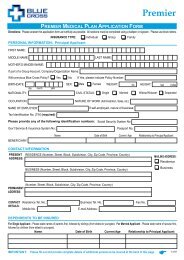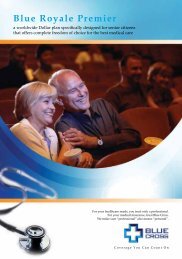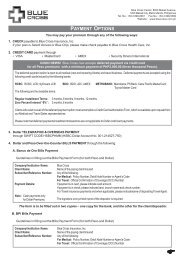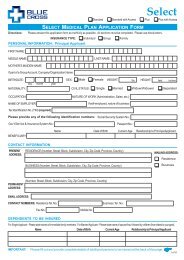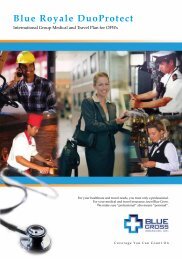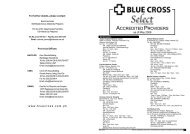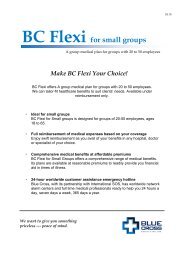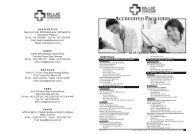Health Book_03-Special Features_2011_web.pdf - Blue Cross
Health Book_03-Special Features_2011_web.pdf - Blue Cross
Health Book_03-Special Features_2011_web.pdf - Blue Cross
You also want an ePaper? Increase the reach of your titles
YUMPU automatically turns print PDFs into web optimized ePapers that Google loves.
<strong>Blue</strong> <strong>Cross</strong> <strong>Health</strong> BOOKXIIunderstanding a new influenza strain2009 H1N1 FLU AND YOUDetails below are from the Centers for Disease Control and Prevention (Atlanta, U.S.A.).Information is as of August 2009.In adults:• Difficulty breathing or shortness of breath• Pain or pressure in the chest or abdomen• Sudden dizziness• Confusion• Severe or persistent vomiting• Flu-like symptoms improve but then return with fever and worse coughIn children:• Fast breathing or trouble breathing• Bluish or gray skin color• Not drinking enough fluids• Severe or persistent vomiting• Not waking up or not interacting• Being so irritable that the child does not want to be held• Flu-like symptoms improve but then return with fever and worse coughAre there medicines to treat 2009 H1N1 infection?Yes. CDC recommends the use of oseltamivir or zanamivir for the treatment and/or prevention of infectionwith 2009 H1N1 flu virus. Antiviral drugs are prescription medicines (pills, liquid or inhaled powder)that fight against the flu by keeping flu viruses from reproducing in your body. If you get sick, antiviraldrugs can make your illness milder and make you feel better faster. They may also prevent serious flucomplications. During the current pandemic, the priority use for influenza antiviral drugs is to treat severeillness (e.g. hospitalized patients) and people who are sick who have a condition that places them athigh risk for serious flu-related complications.How long can influenza virus remain viable on objects (such as books and doorknobs)?Studies have shown that influenza virus can survive on environmental surfaces and can infect a personfor 2 to 8 hours after being deposited on the surface.What kills influenza virus?Influenza virus is destroyed by heat (167-212 O F or 75 to 100 O C). In addition, several chemical germicides,including chlorine, hydrogen peroxide, detergents (soap), iodophors (iodine-based antiseptics) andalcohols are effective against human influenza viruses if used in proper concentration for a sufficientlength of time.How should linens, eating utensils and dishes of persons infected with influenza virus be handled?Linens, eating utensils and dishes belonging to those who are sick do not need to be cleaned separately,but these items should not be shared without washing thoroughly first. Eating utensils should be washedeither in a dishwasher or by hand with soap and water. Linens (such as bed sheets and towels) shouldbe washed using household laundry soap and tumbled dry on a hot setting. Individuals should avoid“hugging” laundry prior to washing it to prevent contaminating themselves. Individuals should wash theirhands with soap and water or alcohol-based hand cleansers immediately after handling dirty laundry.For more information, visit www.cdc.gov.2009 H1N1 FLU AND YOU



